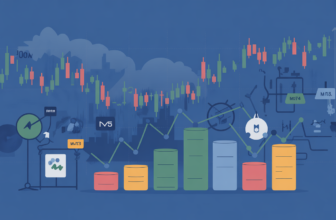
Unravel the mysteries of the Forex market’s closing times and discover the strategic insights needed for success. In this blog, explore the intricacies of global time zones and optimal trading periods, equipping yourself for informed decision-making in the ever-evolving world of forex.
The forex market closes on Friday at 5:00 pm ET, resuming after a 48-hour weekend break. This 24-hour weekday cycle allows global access to trading opportunities.
Key Takeaways:
- Forex market operates 24 hours a day.
- Four major trading sessions: Sydney, Tokyo, London, and New York.
- Trading volume is higher during overlapping sessions.
- The highest trading volume occurs during the overlap of the London and New York sessions.
- Concentrate activity during the busiest trading sessions for optimal results.
What Time Does Forex Market Close
Contrary to traditional financial markets, the forex market doesn’t have a definitive closing time each day. Instead, it operates seamlessly through different trading sessions in major financial centers worldwide, namely Sydney, Tokyo, London, and New York. These sessions overlap, ensuring that at least one market is open at any given time during the trading week.
The forex market, renowned for its continuous operation, presents traders with a unique environment that operates 24 hours a day, five days a week. This non-stop cycle is a result of the decentralized nature of global currency exchanges across key financial hubs. However, pinpointing the exact time when the forex market closes requires a closer look at its structure.
Understanding the intricacies of the forex market’s operational hours is vital for traders seeking success in the dynamic world of global currency exchange. Unlike traditional financial markets, forex operates 24 hours a day, five days a week, owing to the decentralized nature of its exchanges across North America, Europe, Asia, and Australia.
The Four Trading Sessions
The forex market operates 24 hours a day, allowing traders to potentially trade at any time. However, it is important to know the specific trading sessions and when the market is most active. The forex market can be divided into four major trading sessions: the Sydney session, the Tokyo session, the London session, and the New York session. Each session has its own opening and closing time, and trading volume tends to be higher during overlapping sessions. The Sydney session opens first, followed by Tokyo, London, and finally New York. The highest trading volume occurs during the overlap of the London and New York sessions, which is considered the best time for trading opportunities. Traders should concentrate their activity during the busiest trading sessions for optimal results.
- Sydney Session (9:00 pm – 6:00 am UTC): The Sydney session initiates the global trading day, setting the tone for liquidity. Traders focusing on currency pairs involving the Australian dollar, such as AUD/USD, find this session particularly active.
- Tokyo Session (12:00 am – 9:00 am UTC): Overlapping with Sydney, the Tokyo session is crucial for fostering market liquidity, especially in pairs involving the Japanese yen, like USD/JPY. This overlap creates a dynamic environment for traders.
- London Session (7:00 am – 4:00 pm UTC): As a major hub, the London session drives significant forex activity. Pairs involving the Euro (EUR/USD) and British pound (GBP/USD) experience heightened volatility during this session.
- New York Session (1:00 pm – 10:00 pm UTC): Overlapping with London, the New York session forms the busiest period in global forex trading. Pairs such as EUR/USD and USD/JPY witness substantial activity, making it a prime time for trading.
Global Participation in Forex: Navigating the Diverse Landscape of Currency Trading
The forex market, often hailed as the largest financial market globally, thrives on the active participation of a diverse range of entities. From commercial banks to retail forex brokers, central banks to investment management firms, and even individual investors, the currency exchange landscape is a dynamic amalgamation of various players. Understanding the global participation in forex is essential for appreciating the continuous flow of currency trading.
Commercial Banks:
At the forefront of forex participation are commercial banks. These institutions engage in currency trading for various purposes, including facilitating international trade, managing currency reserves, and executing transactions on behalf of clients. For instance, major banks like Barclays and HSBC actively participate in forex, influencing currency prices through their substantial trading volumes.
Central Banks
Central banks play a pivotal role in forex markets, utilizing currency trading to implement monetary policies and stabilize their national economies. For example, the European Central Bank (ECB) engages in forex activities to manage the Euro’s value and influence economic conditions within the Eurozone.
Retail Forex Brokers
Retail forex brokers provide a gateway for individual traders to participate in the currency markets. Platforms like IG Group and Plus500 enable retail traders to access the forex market, offering various tools and resources for trading. These brokers contribute to the liquidity of the market by aggregating and executing trades from individual clients.
Investment Management Firms
Large investment management firms, including hedge funds, actively participate in forex for speculative purposes. These firms leverage their expertise to capitalize on currency fluctuations and generate returns for their clients. Renowned hedge funds like Soros Fund Management, led by George Soros, have historically engaged in high-profile forex trading.
Global Businesses
Beyond financial institutions, global businesses also engage in forex to manage currency risk associated with international trade. A UK-based company trading with the Eurozone, for instance, may use forex to hedge against currency fluctuations, ensuring stability in their financial transactions.
Individual Investors
The accessibility of the forex market has attracted a growing number of individual investors. Through online platforms, individuals can engage in currency trading, capitalizing on price movements. This democratization of forex participation empowers individuals to take part in the global financial landscape.
Continuous Demand for Major Currencies
The constant demand for major currencies, including the U.S. Dollar (USD), Euro (EUR), and Japanese Yen (JPY), ensures ongoing activity in the forex market. These currencies serve as primary instruments for global trade and are actively traded by participants across the spectrum.
The global participation in forex weaves a complex yet interconnected tapestry of various entities, each contributing to the market’s vibrancy. From commercial banks shaping economic landscapes to individual investors navigating currency movements, the forex market thrives on its diverse participant base. Understanding the roles of these entities is paramount for traders seeking success in this dynamic and ever-evolving financial ecosystem.
Peak Trading Times
To optimally navigate the forex market, traders should focus on peak trading times when market activity is heightened. The overlap of major trading sessions, such as London and New York, often results in increased trading volumes and liquidity. Currency pair considerations are also crucial, as specific pairs experience higher trading volumes during the overlapping hours of their respective sessions.
The most active trading periods for each region are:
- New York: 8 a.m. to 5 p.m. EST (1 p.m. to 10 p.m. UTC)
- Tokyo: 7 p.m. to 4 a.m. EST (12 a.m. to 9 a.m. UTC)
- Sydney: 5 p.m. to 2 a.m. EST (10 p.m. to 7 a.m. UTC)
- Europe: 3 a.m. to 12 p.m. EST (8 a.m. to 5 p.m. UTC)
Peak Overlaps and Flexibility of Forex Trading
The overlap of the European and North American trading sessions, during London afternoon and New York morning, marks the pinnacle of daily trading volume. This period, when trillions of dollars change hands, establishes benchmark spot and forward exchange rates through WM/Reuters, influencing various financial entities.
The 24-hour nature of Forex trading stems from its decentralization, global time zone variations, and reliance on computerized networks. Unlike traditional securities, currencies are not bound by a specific market close time, offering traders flexibility beyond New York’s official closure.
Optimal Trading Strategies
- Leverage Overlapping Sessions: Focusing on Tokyo, London, and New York sessions ensures optimal trading activity. For instance, during the overlap of London and New York, traders witness increased liquidity in pairs like EUR/USD.
- Active Trading Times: Traders should engage during periods of overlap, as two or more sessions being open simultaneously result in higher trading volumes. This is particularly advantageous for major currency pairs like USD/JPY.
- Currency Pair Considerations: Tailoring trading schedules based on currency pairs optimizes results. For example, AUD/JPY experiences heightened volume during the overlap of Sydney and Tokyo sessions, presenting opportunities for traders.
Forex Market Time Zone Converter: Navigating Global Trading Hours with Precision
The Forex market’s ability to operate 24 hours a day stems from its decentralization and the utilization of a network of computers rather than relying on a single physical exchange. Consequently, currency trading can occur at any time except during the weekend break, when markets are temporarily closed.
In forex trading, where markets span across different time zones, the Forex Market Time Zone Converter emerges as an invaluable tool. This tool acts as a guiding compass for traders, helping them precisely navigate the intricate web of global trading hours. Understanding how to leverage this converter is crucial for traders seeking optimal entry and exit points in the currency markets.
Functionality of the Forex Market Time Zone Converter
The Forex Market Time Zone Converter is designed to display the current trading sessions in a trader’s local time, providing a real-time snapshot of active markets. This tool takes into account the four main trading sessions – Sydney, Tokyo, London, and New York – and allows traders to align their strategies with peak market hours.
Using the Converter Effectively
- Concentration During Busiest Sessions: The primary objective of the converter is to assist traders in concentrating their activities during the three busiest trading sessions – Tokyo, London, and New York. By focusing on these periods, traders can capitalise on heightened market activity and increased liquidity.
- Optimal Trading Times: The converter aids traders in identifying the most active times by highlighting when two or more trading sessions overlap. This overlap often results in increased trading volumes and tighter spreads, enhancing order execution for more favourable outcomes.
- Avoiding Low Activity Periods: While the Forex market operates 24 hours a day, not all hours are equal in terms of trading activity. The converter helps traders identify periods of low activity, such as during bank holidays or illiquid days, allowing them to avoid potential pitfalls.
Tailoring Trading Strategies with the Converter
The Forex Market Time Zone Converter enables traders to tailor their strategies based on specific trading sessions and currency pairs. For example:
- Currency Pair Considerations: Traders can focus on specific currency pairs during their respective trading sessions. For instance, AUD/JPY may experience heightened activity during the overlap of the Sydney and Tokyo sessions.
- Optimal Trading Session for Pairs: Understanding the optimal trading times for each currency pair is crucial. EUR/USD, for instance, sees increased activity when both the London and New York sessions are open.
In conclusion, the Forex Market Time Zone Converter serves as an indispensable companion for traders navigating the global currency markets. By aligning their activities with the most active trading sessions, leveraging overlap periods, and avoiding low activity times, traders can enhance their decision-making process and improve their overall trading outcomes. This tool underscores the importance of precision in timing, providing a strategic edge in the ever-evolving landscape of Forex trading.
Understanding Forex Trading Sessions and Their Impact on Trading
Each forex trading session has its unique characteristics and market participants. Traders need to be aware of the opening and closing times of each session to optimize their trading strategies. The different trading sessions in the forex market include the Sydney session, Tokyo session, London session, and New York session. Let’s take a closer look at each session and its significance:
The Sydney Session
As the earliest session to open, the Sydney session starts in the evening in certain countries. During this session, traders and financial institutions regroup after the weekend, resulting in initial market action. Although the Sydney session is generally quieter than the other sessions, it sets the tone for the day and can offer opportunities for early traders.
The Tokyo Session
Overlapping with the Sydney session, the Tokyo session is the first Asian trading center to open. It takes in the largest bulk of Asian trading activity, contributing to the liquidity and volatility of the market. Traders focusing on Asian currency pairs like the Japanese Yen (JPY) may find the Tokyo session more favorable for trading opportunities.
The London Session
The London session opens in the early morning in certain countries and is considered the dominant trading session. Given that London is a major financial center, it attracts a significant portion of global trading volume. As a result, the London session generates high liquidity and serves as a crucial period for forex traders. The session’s overlap with the Tokyo session creates a prime time for increased price ranges and more trading opportunities.
The New York Session
Overlapping with the London session, the New York session is influenced by the U.S. dollar and features high trading volume. As traders in Europe wind down their day, those in the United States start their trading activities. The New York session is known for its liquidity and can be particularly active during economic news releases. Traders focusing on major currency pairs involving the U.S. dollar, such as the EUR/USD and GBP/USD, should pay close attention to this session.
Understanding the characteristics and overlaps of each trading session is essential for optimizing forex trading strategies. By aligning your trading activities with the busiest sessions and taking advantage of the increased trading volume and price ranges, you can increase your chances of success in the dynamic world of forex trading.
Optimizing Your Trading Schedule for Success
In order to achieve maximum success in forex trading, it is crucial to strategically plan and optimize your trading schedule. An essential factor to consider is aligning your trading activities with the busiest trading sessions. The key sessions to focus on are the Tokyo session, the London session, and the New York session, as they experience the highest trading volume and provide numerous profit-making opportunities.
Being aware of the specific timings of the forex market is vital when planning your trading activities. For example, if you are trading from South Africa, it is essential to know what time does the forex market close in London, as the London session plays a significant role in global trading and can heavily impact currency movements. By understanding the market hours today and the forex trading session times, you can optimize your trading strategies to align with these active periods.
In addition to timing, it is crucial to stay updated with market news and economic indicators. Major news releases and economic announcements can cause significant volatility in the forex market. Therefore, it is important for traders to prioritize news releases that can potentially impact the currency pairs they are trading. By being informed and prepared for such market-moving events, traders can make more informed decisions and take advantage of profitable trading opportunities.
Another important concept to consider is liquidity. Trading the most liquid currency pairs, such as EUR/USD, USD/JPY, and GBP/USD, can provide more opportunities for entering and exiting trades at favorable prices. These pairs tend to have higher trading volumes and tighter spreads, which can enhance the overall trading experience. By understanding the concept of liquidity and focusing on the most liquid currency pairs, traders can optimize their trading schedule to increase their chances of success.
FAQ
The forex market can be divided into four major trading sessions: the Sydney session, the Tokyo session, the London session, and the New York session.
The Sydney session opens first, followed by the Tokyo session, the London session, and finally the New York session. Each session has its own specific opening and closing time.
The highest trading volume occurs during the overlapping sessions of the London and New York sessions, making it the best time for trading opportunities.
The Sydney session sees initial action as traders and financial institutions regroup after the weekend. The Tokyo session is the first Asian trading center to open and takes in the largest bulk of Asian trading. The London session is the dominant trading session due to London’s status as a major financial center. The New York session is influenced by the U.S. dollar and has high trading volume.
To maximize your trading success, it is important to align your trading schedule with the busiest trading sessions, such as the Tokyo session, the London session, and the New York session. You should also stay informed about market news and prioritize news releases that can impact the currency pairs you are trading. Additionally, trading the most liquid currency pairs and understanding the concept of liquidity can further enhance your trading success.

















